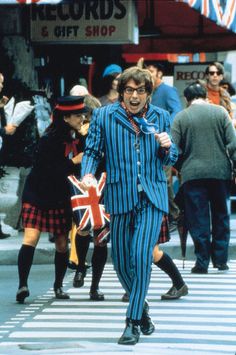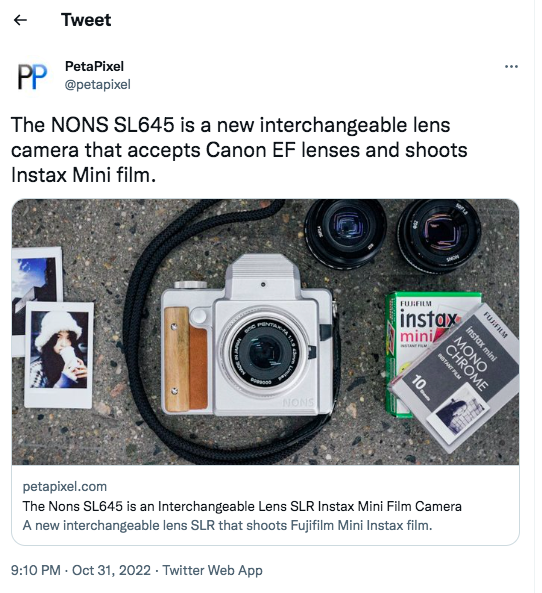Leaderboard
Popular Content
Showing content with the highest reputation on 11/01/2022 in all areas
-

Nikon Z6 + Atomos Ninja Star footage
The Dancing Babamef and one other reacted to kye for a topic
The original claim by @The Dancing Babamef was.... My reply was simply that YouTube is good enough to show the difference between: Resolution X sensor -> Resolution X timeline -> Resolution X YT upload Resolution >X sensor -> Resolution X timeline -> Resolution X YT upload It doesn't matter if X = 4K or 1080p, YT quality on both of them is enough to see differences. I think people form the opinion that YT is completely useless and don't think it can do anything because of the way it handles grain (i.e. a bloodbath) and the high quantity of very low quality uploads where the footage has been crunched way before it made it to YT. I'm yet to understand what makes a YT upload look worse or better, but there is definitely a lot of variation across different channels / videos. In terms of a 4K sensor -> 1080p timeline -> 4K export-> 4K upload, that can benefit hugely from a little bit of sharpening. Most of the people that think that 1080p is completely inferior to 4K are seeing the extra YT bitrate from the 4K YT stream, or are simply looking at sharpness, which is easily compensated for in grading.2 points -

Deciding closest modern camera to Digital Bolex look
tupp and one other reacted to Andrew Reid for a topic
Nobody is allowed an opinion if they haven't first developed, designed and marketed a cinema camera. I guess we should all just shut up then Apart from tupp?2 points -
Technical Myths and Wasted Performance of A7S III Sensor IMX510
Juank reacted to androidlad for a topic
1. The pixel-level read node design is similar to IMX610, only the implementation is different and dictates that it has fast conventional read speeds. 2. The physical pixels are 49 megapixels and the entire sensor is natively designed to be 49 megapixels, reusing the 4.2um BSI pixel design and using both analogue binning and digital binning together to achieve a 12 megapixel sensor. 3. IMX510 disables the all-pixel readout mode, so there is no possibility of an all-pixel readout, and naturally it cannot achieve 2x2 OCL AF, which is the biggest difference between it and IMX472. 4. Dividing IMX510's logical pixel into four physical pixels. The readout is achieved using 1:2 analogue binning before PGA and digital binning after ADC. The specifics are: A. 48 physical megapixels, divided into upper left, upper right, lower left and lower right in-group pixels. B. 24 mega pixels are read, binned in the form of upper left + lower right, upper right + lower left, dual stream 14bit readout. C. 2:1 pixel binning in the digital domain to generate 12 megapixels at 15bit, discard 1bit to 14bit output. D. The readout speed is around 21ms, approximating 48fps; when the precision is reduced to 12bit, 96fps can be achieved. E. The ADC does not have an 11bit mode, so it cannot achieve the faster 24M 11bit -> 12M 12bit. F. The digital binning discards 1bit of precision regardless of the mode of output, a waste of performance deliberately designed into IMX510. G. In one video mode, the internal readout of two 3.84K/128fps 12Bit ADC streams are digitally binned, but the resolution is not twice that of 3.84K. The precision and resolution are wasted. 5. Due to the uniqueness of the readout mode, IMX510 cannot achieve any 2x1 OCL in-group AF, and the orthogonal readout pixel groups cannot be used for phase detection. Therefore the only phase focusing design for the IMX510 is masked PDAF. A focusing method using 2x2 OCL AF will only be available when the all-pixel readout mode is unlocked. 6. The hardware performance of the sensor goes well beyond the limitations of the "IMX510" name. 7. If this sensor were to be a normal Bayer sensor, the readout speed would depend only on the total number of analogue pixels before the ADC, due to the pixel readout design. Thus 48 megapixels at 24fps 14bit. For this a Modified Bayer CFA can be used, which is suitable for pixel designs with 2:1 analogue signal binning - maximising its performance and enabling dual mode switching between high resolution and oversampled high speed shooting: Crop to 16:9 to achieve 8.5K/57.7fps 12bit, 2x4.35K/115.5fps 12bit respectively; crop slightly to 7.68K/64fps 12bit, 2x3.84K/128fps 12bit. Notably, its 2x3.84K/128fps 12Bit readout truly has double the resolution and achieves IMX301-like oversampling performance (Sony F65RS). 8. The readout speed of any column-parallel ADC design of an image sensor must be scaled by the line readout speed, by the total number of pixels multiplied by the number of columns, and at the same level of precision comparing: A 48 megapixel 14bit 24fps sensor reads at a larger scale than a 12 megapixel 14bit 48fps sensor, but we cannot call it a greater total number of pixels read out, but rather a faster readout, measured by miliseconds. At a given precision, readout time (the time taken to read a frame), readout scale (how many pixels are read in a second), and readout speed (how many rows of pixels can be read in a second by a column of ADCs), are three dintinctly different and important metrics.1 point -
Available shortly… S1H being collected tomorrow for a sensor clean before sale. S1R going off to hopefully have a ding sorted that has made the battery door a bit stiff, plus needs a new eye cup after a dog bit it. Yep, weddings can be dangerous places! S5 also departing to have the LCD hinged repaired. That one was totally me. Sigma 28-70 and Panny 25-105 I am currently holding onto just in case L Mount announces anything as those 2 are good workhorses for me. Meike 50mm T2.1 in EF Mount with the Fotodiox VND adapter. All the rest is being collected by MPB tomorrow!1 point
-
Not an audio expert by any stretch but it does feel like there are so many really great but also really affordable options out there. I still use a Zoom F4 and an older Marantz PMD661, but aside from keeping my eyes out for a great price on a used Mixpre-6 II - I think I'm good with what I have until one or all of them break. So @IronFilm I do wonder what that means for the audio recorder market - bcuz it does feel like it might've hit a brick wall?1 point
-
A7RV announced
IronFilm reacted to newfoundmass for a topic
One thing though that IS annoying me about Sony is that they're becoming more insular. That certain features are becoming dependent on using Sony lenses, Sony software, etc. feels like a move in the wrong direction. You can argue that it's necessary to achieve some of these features but, for example, I don't see a valid reason why they can't work with Sigma or Tamron to ensure their most popular lenses work with things like focus breathing compensation. It wasn't long ago that Sony relied on them to beef up their lens selection and a lot of people bought into it because of them.1 point -
A7RV announced
hansel reacted to newfoundmass for a topic
If I had to make a choice right now about what system to go all in on it'd be Sony. But I wouldn't be happy about it. Like @MrSMWit's not that I hate Sony, it's just I'm not inspired by them. I don't ENJOY using their cameras and I've never been a big fan of the images they produce. It's not that they're bad, it's just... They're Sony. The FX30 is nothing special, but the price? It's hard to beat. It'd be very easy to buy 2 or 3 of them for my work and be done with it. And the system's long term health is guaranteed. I'm thankful though that I'm not in a position where I need to make that choice, and can further see what everyone else does in the next year or two before deciding what direction I go in. I'm probably putting too much faith in Panasonic, but I do think they'll announce something big next year. I think they have to, their long term viability I think depends on it.1 point -
Audio field recorders in 2021? My Predictions ("wild guesses").
kye reacted to newfoundmass for a topic
Your perspective comes from a much more controlled environment than what the majority of people out there are working on. That's not to say your perspective isn't welcomed, because it is an interesting one even if most of us on this forum will never work at that level, but sometimes I think you forget that. @kye's question was whether 32 bit float gives you headroom in the event you need it, not whether 24 bit is sufficient when you're on a set with a dedicated sound guy. (The answer is yes, btw. You're only limited by your microphone, as there isn't anything on earth that is loud enough to distort 32 bit audio. As long as the sound isn't too loud for your microphone you're good to go.) The Tascam X8 (or other low end 32 bit float recorders) won't give someone audio that's better than a professional sound guy with professional gear can achieve. But for low budget projects or hobbyists, where it's not incompetence but the inability to juggle everything at once that necessitates recording on 32 bit, it's a HUGE deal and gives them a fighting chance. And eventually even sound professionals will embrace it once they let go of their pride. 😉 Me? I'm just happy that I don't have to worry about the 300 pound pro-wrestlers clipping the audio when they're yelling and hollering because I'm nowhere near the recorder and even if I was it'd be a nightmare to adjust the sound while also filming something so chaotic and unpredictable. Now I can get the shot AND get good, clean audio. 😊1 point -
Audio field recorders in 2021? My Predictions ("wild guesses").
kye reacted to newfoundmass for a topic
Thankfully I'm not in the film industry but in the video production industry. 😉 32 bit float has been liberating as a one (or two) person crew. Setting my levels once (I still choose to), and not having to worry if someone (or something) gets too loud is beautiful because I have the range to still pull it down if they clip. It's not perfect, sounds can still be too loud for the mic itself obviously, but I've yet to experience that. I've just experienced lovely audio so far. I've never had enough hands to properly mix or adjust audio live the way I wish I could. Before I'd have to set my levels lower to be safe because I wasn't in a position to adjust them on the fly. Now I'm able to record two wireless handheld mics, the soundboard, and a crowd mic all at once with no clipping and without the noise that comes with adding gain in post. Everything gets written off as marketing or a gimmick at first. And for a lot of people it is completely unnecessary. But it's a game changer for a lot of people.1 point -
Let's give a camera analogy to help you understand: Let's pretend you have a camera that can record 16bit raw video files. (such as the Sony PMW-F55) Would you need 20bit raw video files?? No, of course not. (heck, even 16bit is overkill for most people! With 10bit being probably the most common bit depth) If someone is regularly messing up their exposure so badly with 16bit files that "it isn't enough", then I think they've got much bigger issues than what bit depth they're recording in! Likewise, the amount of dynamic range in 24bit audio files is huuuuuuuge, you've got to be quite incompetent to not find that to be enough. (it isn't like back in the bad days of 16bit, when you had to be very careful to have your levels well above the noise floor while still being low enough not to peak, which meant for a fairly narrow window you had to aim for) Let's have another camera analogy: if you're recording with a camera that only ever outputs 8bit 420, then why on earth would I want to record externally with a 12bit 444 recorder??? That's the case with audio, when 100% of the dialogue is being captured wirelessly. Thanks 🙂 Maybe in January I'll make a 2024 prediction! haha1 point
-
Aftern hearing about this company in another topic after a few years, they've released some software to help people shooting cDNG. I've not yet tested it, but it looks pretty good. Essentially it's just playback and light raw controls for now, but their roadmap suggests they're working on exporting to ProRes, which will be great for cameras like the Sigma FP, that only record uncompressed. https://www.octopuscinema.com/wiki/index.php?title=OCTOPUS_RAW_Player#Installer1 point
-
I was only joking here with the character behind that project, in the same way that he did. I apologize if I have offended you. I have never developed a camera. I don't even dedicate myself full time to filmmaking. Sorry1 point
-
1 point
-

Topaz Video Ai (version 3.0)- any good?
kye reacted to Andrew Reid for a topic
No more of him on this forum please @kye1 point -
Nikon Z6 + Atomos Ninja Star footage
The Dancing Babamef reacted to TomTheDP for a topic
Let's say you are recording in camera, downsampling to HD from 4k in camera, like the original poster did. Even though your file is natively HD I still think rendering it in 4k, which makes YouTube upload it in 4k will give you a better result. The footage itself won't look any sharper, but the extra 40mbps YouTube gives 4k makes a difference. I am not saying you disagree, just clarifying my thoughts/experiences with YouTube. my 2 cents1 point -
Well I got this right. The Nova2 didn't come out in 2021! But it did in 2022... which was a surprise to me. https://www.jollypostie.com/store/gotham-sound/meet-the-zaxcom-nova-2-and-new-zmt4s-62f2ea42cfd0e However the Nova2 was a relatively "small" update. (but very handy for those who it does scratch that itch the original Nova wasn't managing to reach) Well, I guess I kinda got this right? Sort of. The Zoom F8n Pro was formally hinted at in 2021, and officially announced early in 2022. But the F8n Pro was also a very small update, not the bigger "F10" update I was hoping for. Ah well, but in general my predictions ("not much will happen") for 2021 I got right!1 point
-
1 point
-
I also liked Grimors joke. I think he for sure developed a good taste regarding insider camera jokes. If we have camera developers with a sense of humor around, I would love that for both facts, for their development skills and their humor as well. 🙂 Too bad that out of the 3ccd 2/3 sensor cameras like the Varicams there never materialized a camera in the body of a DVX100 or HPX250, the latter though with great codec, but without ccd magic and 1/6 sensor size.1 point
-

A7RV announced
ntblowz reacted to Andrew Reid for a topic
Maybe a sign Sony are overtaking Canon & Nikon in sales figures. A YouTuber's favourite camera is the one that generates the most affiliate commission with B&H.1 point -
It wouldn't shock me at all. There will always be a market for monitors and recorders, but cameras are increasingly adding features and codecs that you needed recorders for in the past. The ability to record RAW was important short term, but it's only a matter of time before these companies develop their own flavor of RAW or implement ProRes RAW or BRAW directly, leaving Atomos out in the cold. It's hard to see where the camera industry will be in 5 years, let alone the monitor/recorder industry, but I imagine the former will be in better shape than the latter, especially with so many budget monitor options out there now and in the future.1 point
-
Fuji X-H2 in the house
kye reacted to Attila Bakos for a topic
Here is a short demonstration of the Cr channels: https://drive.google.com/file/d/1veiqGodXKxerdNF_ksqLlAnFWbGQUtEe/view?usp=sharing 8bit is rubbish, never ever use it. 10bit is somewhat better than on the X-T3/4, but the chroma smoothing is still there, ProRes doesn't seem to help either. Interestingly the X-H2s seems to have more smoothing than the X-H2. As much as I love Fuji for stills, I think I'll stick to other brands for video as I'm very sensitive for this kind of stuff, but for 99.9% of Fuji video shooters this is still a non-issue I guess.1 point









